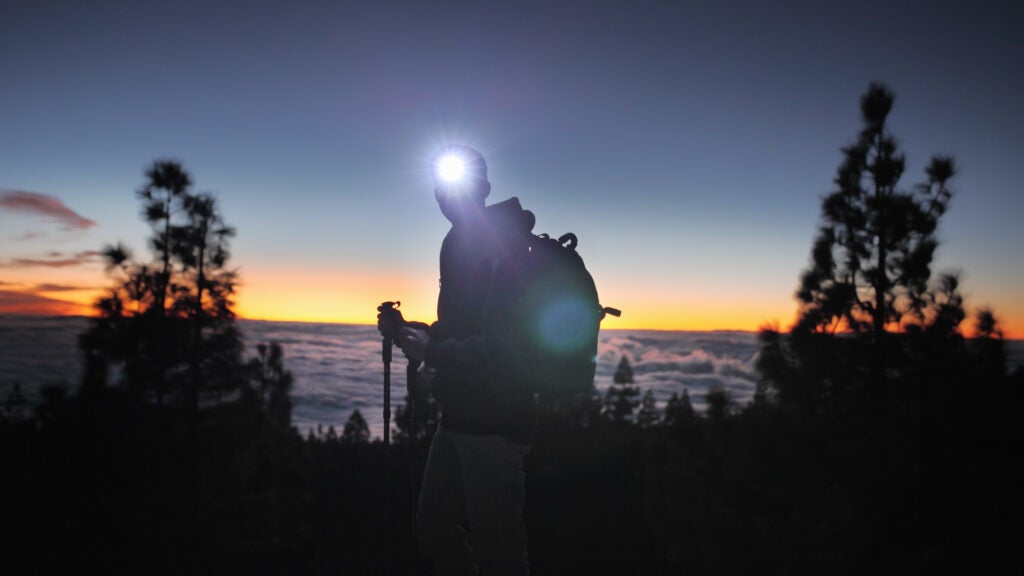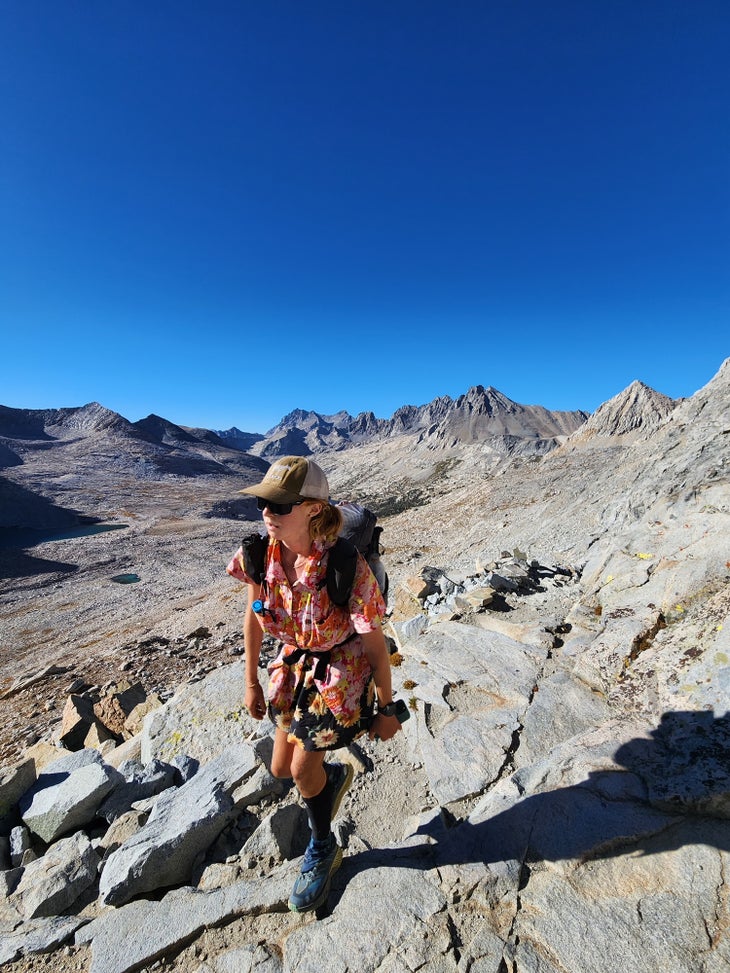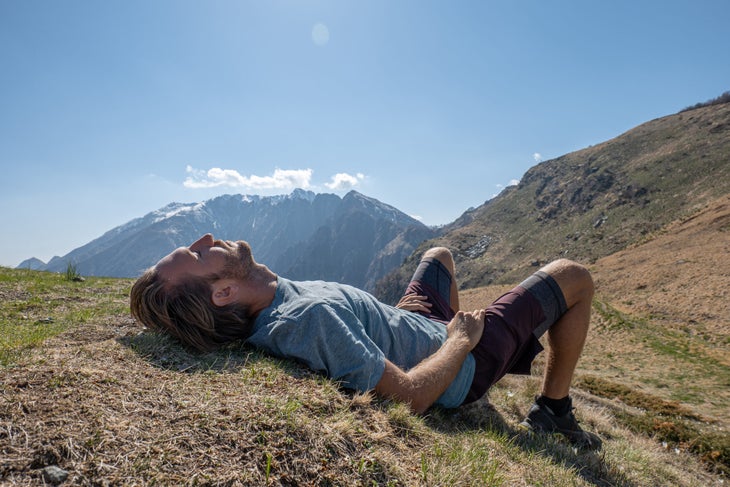



After seven weeks of what felt like non-stop motion on the PCT, Nick Fowler began seeing things. Boulders looked like objects. Trees became people. He had endured every different kind of weather, and while the scenery was non-stop beautiful, he was spending most of his time looking at his feet, and the rocks he was tripping over.
“I don’t know if these were hallucinations, or if I just really wanted them to be there, but multiple times when I had only slept for three hours, I would see a boulder and think it was a cooler full of pop,” he said.
Fowler, 35, who set a new self-supported FKT on the Pacific Crest Trail this past September, knows a thing or two about sleep deprivation. When he set out, Fowler set a goal of sleeping six hours a night—hiking from 4 a.m. to 10 p.m. But as he learned on his attempt, good intentions don’t always pay off when you’re trying to go fast. That’s when the rocks turn to pizza boxes and coolers full of beverages.
It’s also when things can get dangerous. Near the end of his hike, Fowler began falling constantly.
“I was tripping over everything. I would trip on a rock and fall and hurt my knee and then would just be bawling. Not because of the pain, but I was just sick of tripping and falling,” he said.
Fowler’s reflexes were fading. According to neuroscientist Scott H. Frey, this is a sign of serious damage to the nervous system—and can be especially risky when navigating technical terrain in the backcountry.
As fastpacking and ultrarunning grow in popularity, records on popular long trails around the U.S. seem to be dropping all the time. In the past, FKTs have stood for decades, but in recent years, they may stand for only months at a time. Betsy Kalmeyer’s supported Colorado Trail record stood for almost 20 years before Tara Dower broke it by nearly 13 hours this past summer. Then, Nina Bridges broke Dower’s record less than a month later by nearly 8 hours.
Are hikers getting faster? Maybe, but the true explanation for this advancement seems to be in sleep—or lack thereof. FKT seekers push themselves to incredible daily mileage, and then collapse in the dirt, sometimes for an hour and sometimes for mere minutes, to try and get a brain reset. Hiking on fewer and fewer hours of sleep is allowing athletes to push boundaries on the trail, but what does this do to a person’s brain and body?

Frey says that scientists know very little about the long-term effects of sleep deprivation paired with 18 or more hours of strenuous activity.
“The military has always had programs on human performance and sleep deprivation—how people operate when they’re under stress and can’t sleep,” he said. But he suspects none of those studies included anything close to what thru-hikers attempting FKTs voluntarily put themselves through.
A “normal” sleep pattern for an adult human involves several 90-minute REM cycles, each of which includes all the stages of sleep. Completing multiple cycles allows a person to rest and recover by releasing growth hormones and rebuilding damage to tissues and cells. Through this process, Frey says, we’re also able to learn.
“We consolidate a lot of the new information that we’ve learned during the day and form memories,” he said. “They’re very unstable until they get stabilized or consolidated when we sleep.”
While FKT hikers aren’t in a classroom learning lots of new information every day, they do experience unique situations that require problem solving. In addition to impairing memory, sleep deprivation compromises cognitive functions like attention and perception.
It doesn’t take much sleep deprivation to throw the body and brain out of whack.
“Even just messing with sleep cycles for work can be harmful,” Frey said. Studies show that healthcare professionals who work swing shifts experience compromised health. Could sleep deprivation on a long distance hike have the same consequences?
Many thru-hikers and FKT seekers plan their efforts with sleep cycles in mind, often aiming to get 3 or 4.5 hours of sleep (a few REM cycles) nightly. In other words, FKT-seekers aren’t uneducated about the need for rest—they’re just chasing goals that require them to push their rest schedule to the absolute limit.

The same is true for Nina Bridges, 23, who completed the PCT yo-yo last year—she hiked south to north and then back—becoming the seventh documented person to complete the feat, and the second woman. Bridges unofficially (she didn’t document the journey with a GPS device) holds the record for women in 190 days and 6 hours.
This year, Bridges completed the 486-mile Colorado Trail in 8 days, 14 hours, and 15 minutes, just 47 minutes off of the men’s record. Past experiences taught her that sleep, much like nutrition, requires a plan. For her, that plan included acclimating to the elevation she’d be sleeping at on the trail.
When she’s not setting FKTs, Bridges works for Outward Bound in Leadville, Colorado as a backpacking and climbing instructor. She credits living, working, and sleeping above 10,000 feet for her ability to get solid rest on the CT.
At the suggestion of friend and fellow FKT-chaser Josh Perry, Bridges set a goal of sleeping according to complete REM cycles. For her, this meant shooting for 4.5 hours each night.
On supported efforts, many hikers have the luxury of assigning other people alarm duty. Bridges handed her phone and watch over to someone on her crew each night, so that if she woke during her sleep period she wouldn’t know what time it was and could avoid stressing about how much time she had left to sleep.

Many FKT hikers also describe doing “evening duties” in their last mile or so, in order to get to sleep as quickly as possible when they stop. They do things like eat a good dose of protein and take vitamins to help muscles recover before they ever stop walking. They also brush their teeth on the move, and slow the pace to bring their heart rate down.
“The idea was, any time I’m not moving I should be sleeping,” Bridges said. “As soon as we stopped walking I would be asleep 10 minutes later. And then I’d wake up in the morning and be walking in eight minutes.”
A common side-effect of sleep deprivation during endurance efforts is hallucination. Some people have full-blown animated-movie-like visions, and others just sense things moving around them. It’s almost impossible, because of how our vision and perception work, to not experience some version of hallucination with so much motion.
Frey says very long periods of movement aren’t natural for humans. “Eighteen hours a day of moving—we’re not set up to be getting that much motion stimulation,” he said. “The next time you’re at a waterfall, stare at it for a while. Just watch the water falling for a whole minute. And then look off to the side where nothing is moving. It will look like the ground or trees are moving up.”
Constant motion fatigues certain receptors in the brain, causing a sensory overload that can throw vision and perception out of whack. Bridges experienced this on her CT hike. “I often had trouble focusing my eyes,” she said. “I noticed it when I was using any pit toilet. I would stare at the wall and the wall would start moving. Kind of like pulsing.”

Even when hikers return to a regular schedule off the trail, the effects of sleep deprivation can be long-lasting. Those attempting long FKTs with strict schedules often report experiencing nightmares and night sweats after they finish their hikes.
Kim Levinsky, 35, an ultrarunner who holds the supported FKT on New York’s Long Path, had extensive sleep issues even after she was off the trail.
“After the Long Path, it was a full three weeks of having crazy nightmares,” Levinsky said. “A lot of times in the dreams I’d be trying to get off the trail, like ‘where is the crew car?’ And I’d wake up and either be sweating or have an elevated heart rate.”
After completing his PCT record, Fowler woke up in a sweat for weeks, and experienced a persistent general confusion. “I can’t even describe how exhausted I was. Just this mental fog that melted into my body.”
Despite the serious physical and mental toll, more and more athletes are hiking further and sleeping less. And for many, it’s worth the consequences. John Kelly, 38, who set the supported FKT on Vermont’s 249-mile Long Trail in July, is drawn to the unique challenges of these ultra-endurance feats.
“It’s a way of putting ourselves in this state where we’re forced to deal with our basic needs,” he said. “It really pushes us to a point that we don’t otherwise experience in the relatively cushy modern life that most of us have. It teaches us about ourselves. It teaches us how we respond in those situations, how we can do better, what our strengths are, and what our weaknesses are.”
Kelly’s thought is that long-distance hiking challenges are relatively safe—especially when done with the help of others, or in the context of an event.“If I fail, that usually means I fell asleep. That’s fine. I’m not getting chased by a lion. I’m not in a warzone,” he said.
Frey, on the other hand, isn’t so sure. While thru-hikes and ultra races seem like controlled environments, Frey argues that deeming them “safe” might be a bit of a stretch. There’s still not enough research to say how much sleep deprivation a person can go through before lasting damage takes place.
“Right now, I think there are still just a lot of unknowns,” he said.
From 2023

